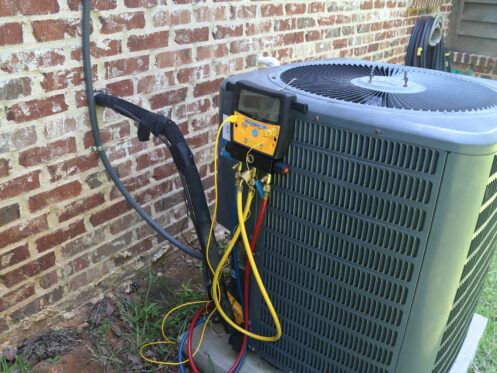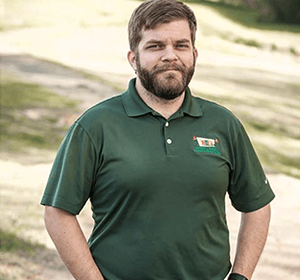When your AC fails to produce cool air, it’s easy to jump to conclusions and think you may need to replace your system. Fortunately, there are many issues that could be at play, including some that are easily fixed. Consider these nine common issues that may prevent your AC from cooling your home.
1. Dirty Air Filter
A dirty and clogged air filter is one of the most common AC problems property owners across the country face. This is because filters require routine changing, usually every 30 to 90 days if your system uses the common 1- or 2-inch filter.
When the filter gets dirty and clogged, it restricts airflow into the system. Without air flowing in, you won’t have air flowing out, which means your system won’t be able to cool your home. A good place to start for nearly every problem you may notice is checking and replacing your system’s air filter.
2. Thermostat Improperly Set
The thermostat is the brain of every HVAC system, telling it when to start and stop cooling cycles. If it’s not set properly and sending the right signals at the right times, your AC won’t cool your house.
The first place to begin with your thermostat is to check that you actually have it on cooling mode. While there’s always a reason behind how the mode gets changed, it’s not always readily apparent, and it may seem as though it did it on its own. However, it’s an easy fix to get it back to the “Cool” setting.
Next, check the fan setting. This should remain set to “Auto,” which tells the fan to run only while the system is running a cooling cycle. If it’s set to “On,” it will run constantly regardless of whether the compressor is operating or not.
Finally, if you have a smart thermostat, check its programming to ensure that it is set properly. This will automatically adjust the temperature to help reduce your cooling costs while you’re away from the house. Be sure to check both the time on your thermostat and the program times and temperature settings.
3. No Power to the Condensing Unit
Your unit must have power to cool your home. While a tripped breaker inside will prevent the entire system from cycling, the disconnect box is a separate device. This is a special safety mechanism to prevent power from flowing to the condenser unit during service.
If you’ve recently had maintenance or a repair visit, it’s possible that the disconnect switch is still set to “Off.” If there isn’t currently work being done, you can turn it back on, which may resolve the issue.
4. Inside Airflow Restrictions
The air filter isn’t the only place that can experience an airflow restriction inside your house. Another very common issue is blocked or closed supply vents. Air must flow freely from these vents to allow the cool air to circulate throughout your home the way the system is designed to make it do.
This not only means they must be open, but that they must also have adequate clearance. The minimum recommendation is 6 inches above and around each supply vent. You must also keep all of your return vents clear. The proper clearance for these depends on their size, so work with your HVAC technician to determine what’s appropriate for your home.
5. Bad Circulating Fan Motor
If your circulating fan isn’t spinning fast enough, it won’t draw the amount of air through the system needed to cool your home. However, that’s exactly what can happen as the fan motor ages or wears due to excess strain. Further, the motor contains bearings that allow it to spin, and these need lubrication to continue working properly. That lubricant may need replacing if the motor is not a sealed model. The lack of it causes the motor to work ineffectively. Fortunately, the circulating fan motor is one of the key components that technicians focus on during routine AC maintenance.
6. Malfunctioning Compressor
The compressor is responsible for building the pressure at the condensing coil so that the refrigerant can expel the heat it absorbed from inside your home. When the compressor doesn’t work properly, the coil can’t expel the heat, which then affects how much heat it can absorb to continue cooling your space. The compressor is a complex device and may have issues ranging from electric current flow to broken internal parts. A technician will test the compressor to ensure that it’s operating correctly, which may include testing electrical continuity, refrigerant pressure, and how the compressor sounds while running.
7. Dirty or Blocked Condensing Unit
Like your indoor unit, the outside condensing unit relies on the ability to draw air in and then vent it out. Two issues commonly inhibit this air movement, a dirty coil or something blocking air from the unit.
The condensing coil is visible from the outside on most units, which means it’s susceptible to collecting dirt, dust, pollen, and many other things floating around in the air. To prevent this, gently rinse the outside of the unit with water from your garden hose. Just exercise caution not to use high-pressure water, either from a nozzle or a pressure washer, because it can damage the coil fins.
Additionally, like the vents inside your home, your condensing unit needs enough space around it to draw air in and vent it out. Obstructions can include grass, weeds, and branches from bushes and trees. However, fences and other features you install to conceal or protect the unit could also obstruct it. Most manufacturers recommend keeping at least 2 feet around the unit and at least 5 feet above it clear.
8. Low Refrigerant Charge
Air conditioners rely on having the proper amount of refrigerant to build the pressure needed to vent the heat absorbed inside the house. Further, low refrigerant charge can also cause coils, refrigerant lines, and even the compressor to freeze. Frozen components cause two issues. One is preventing air from flowing over the coils, and the other is preventing the refrigerant from flowing through the system. In both cases, the system may appear to run but not produce cool air from the supply vents. Low refrigerant is not something that should naturally occur; it’s indicative of a leak. This is why a maintenance technician will test the pressure during a tune-up.
9. Leaking Ductwork
Central air conditioners rely on ductwork to transport the cool air around your home. However, if those ducts leak, they can allow the cool air to escape and warm air to enter. This reduces the temperature drop at the supply vents, making the system less effective at cooling your entire home. Leaking ducts can be resolved by either having your ducts sealed or by replacing the ducts if they are in a condition that makes sealing ineffective.
Bobby L Greene Plumbing, Heating & Cooling Co. has proudly served the Shreveport community for more than 60 years. Our expert team provides heating and cooling repair, maintenance, and installation along with plumbing services ranging from water heater and fixture installation to drain and pipe cleaning and repair as well as water filtration options. Call us today to schedule an air conditioning repair or maintenance visit with one of our trusted technicians.

